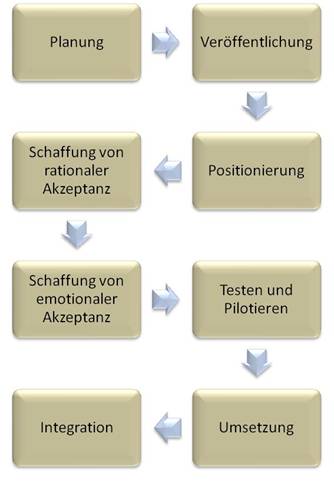In our projects, transition management includes strategy definition, implementation planning, and, above all, establishing the changes in the corporate environment:
Change processes are complex structures. They very often contain factual, emotional, psychological, and systemic components.
As they have an impact on a wide variety of levels, such as that of the individual, an extensive network of relationships, or even the entire organisation, the transition process and its interdependencies must be influenced and managed in a targeted manner.
Your contact person

Carsten Fabig
Managing Director
The 8-stage approach of Vineyard Management Consulting GmbH utilises a multi-stage procedure for the successful design of transition processes.In particular, emotional and rational degrees of acceptance of the change phase are taken into account.
Phase 1 – Planning: At the start, modern methods are usually used to rationally analyse why a change is necessary and then plan what it should achieve.
Phase 2 – Publicising: In this phase, the need for change is publicised, which often results in certain target groups being emotionally affected and surprised by the change.
 Phase 3 – Positioning: All target groups normally position themselves here. It is crucial to explain the need for change in a target group-oriented manner and to work towards creating a common awareness of, for example, the objectives, opportunities, and risks as well as the framework conditions of the upcoming initiative and the transition process set up for it, despite different interests.
Phase 3 – Positioning: All target groups normally position themselves here. It is crucial to explain the need for change in a target group-oriented manner and to work towards creating a common awareness of, for example, the objectives, opportunities, and risks as well as the framework conditions of the upcoming initiative and the transition process set up for it, despite different interests.
Phase 4 – Creating rational acceptance: This important step is used to gain the trust of target groups (and above all, key people for a successful change) in the transition process and its process organisers.
Phase 5 – Creating emotional acceptance: In this phase, the (real) emotional acceptance of those affected and involved is secured through a serious, binding, and in-depth examination of the fears, risks, and concerns of the target groups.
Phase 6 – Testing and piloting: Next, resources are activated, projects are launched operationally, adjustments are tested or piloted, and opportunities for change are identified - the change takes shape!
Phase 7 – Implementation: Only then (!) are the most streamlined and targeted change projects ideally implemented, e.g., with the help of clear prioritisation, clear responsibilities and roles, and consistent behaviours.
Phase 8 – Integration: Finally, the transferred structures, processes, IT systems, behaviours or strategies are integrated into the ex-post transition phase. The transfer into new habits, the stabilisation of new learning experiences, and ongoing success monitoring should be emphasised here, as well as the rewarding of successes and recognition for achievements in the previous phases.
 If there are so many models, why do so many things still go wrong?
If there are so many models, why do so many things still go wrong?
In general, the problem with many of our clients lies primarily in the application and the experience of the protagonists in dealing with transformation processes.
Examples of possible reasons for failure are:
- Too much self-satisfaction
- Insufficient support
- Unclear goals
- Lack of communication, unclear information situation
- Too few short-term successes
- Lack of integration of change
- Processes and decisions take too long
We would be happy to help you avoid these dangers and successfully organise your transformation processes - we look forward to hearing from you!
Realised projects (excerpt)
Banking
Transition management of a global reorganisation (incl. outsourcing to service centres) of a business unit with over 5,000 employees
Telecommunications
Change support during the integration of the mobile and fixed network division and process reorganisation of an IT solutions division
Insurance
Change and transition management for the strategic repositioning and the associated restructuring and implementation of the new business model
